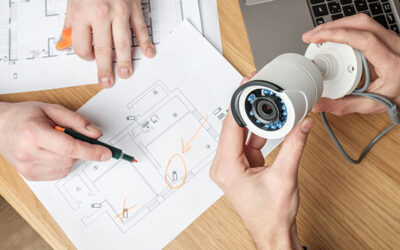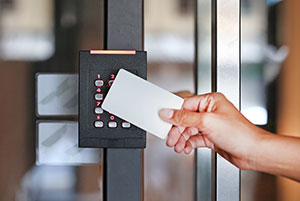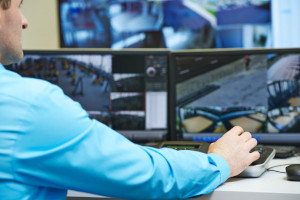A security camera system can range from 1 camera to hundreds of cameras at the one location. The camera is a video recording device that captures live footage of your property. This footage is then stored on the hard drive of the recorder and/or back up in a web-based cloud account. Security cameras are available as hardwired or wireless depending on application needs.
Remote Viewing
If your security camera system is networked on your internet or company network, you can then view your camera footage live or look back and retrieve old footage. This can now be done via the smart software and apps on PC, Laptop, Tablets and Smart Phones. You will need live internet.
If you have multiple sites, you can have these all combined to view from the one software login and view various cameras from various sites on the one PC. You can even nominate which cameras you would like to see on your monitor grid for each site as a fast reference each day.
Cabling
The latest technology is now IP and this is run on CAT5e or CAT6 cable. Cameras come in various megapixel but at the time of writing this article, 4MP, 6MP and 8MP are very cost-effective options. Exceptionally good image quality can be experienced on most of the 4MP, 6MP and 8MP. It all comes down to the application type. That being the location of the camera (distance, height) what you are trying to capture (persons/ moving vehicles etc.) and lighting. A certified security technician is the best person to speak to when assessing cameras for your site. There are some sites that have existing RG59 (coax) cable which supported the old analogue cameras. This cabling can still be utilized in hard-to-reach places. You can install either the upgraded HD Analogue camera range with OK image quality or install IP converters on the ends of each cable and run IP cameras over them. This is not the most ideal or cheapest scenario, but it can be done for situations were running a new CAT5e cable is not an option.
Recorder Types
DVR is the old analogue recorders and accommodates analogue and HD analogue cameras. NVR accommodates IP camera technology. You can also purchase Hybrid machines that will accommodate a mixture of all technologies. This is best used when planning a partial upgrade of your site.
Remote viewing of your footage gives total peace of mind whether you are away from your property or inside your property. See who is lurking around your house, who is at your front door, if your staff arrive to work on time, report effectively on a workplace incident, capture theft and/or damage to property, watch the kids play in the back yard or pool whilst your cooking dinner, monitor your pet’s activity whilst not at home, check on property during storms, provide evidence to insurance companies, assist local police with community crime to catch perpetrators. The benefits are endless.
You can set your system to record 24/7 continuous video recording (CVR) or record on motion only settings. When set up on motion only, the cameras are always live however it will only begin recording when there is motion on that camera. The camera picks up this motion and begins recording to the hard drive or cloud. Most new systems also accommodate approx. 10 to 30 seconds beforehand with the recording (dependent on brand features). The benefit of motion only recording is that it frees up hard drive space and you are left with only footage that has active recorded footage. You are not left searching through no activity footage.
Hard Drive Space
Once the hard drive is full of video footage, it will begin recording over the oldest footage first. Therefore, it is important for you to review your recording space after the first 30-60 days to determine your true storage space. If you have a minimum storage day requirement, please advise your provider at the time of quoting and they will allow for this when considering number of cameras, settings and onsite activity. Most commercial sites require minimum 30 or 60 days. Residential can get away with 2 weeks to 30 days. Its dependent upon your personal needs. The machines can be programmed to alert you if there is a problem with the hard drive.
Cloud based recordings will come with a monthly fee for storage and can become an expensive ongoing exercise. It can however be networked locally to record onto the hard drive of the physical machine on site and no ongoing storage costs. You can also opt for a back up hard drive as precaution & cloud based should you have the need. This is generally only required for large high-risk sites.
The latest cameras have numerous options to allow the user to set up alerts and minimize false alarms. Using a combination of features, you can distinguish between a person vs. car, cat or dog etc.
Smart Motion Detection (SMD)
Can differentiate between humans and vehicles within the cameras field of view. It will trigger an alert if a person or vehicle is in the picture. It is suited to low populated scenes where the user wishes to be alerted for the presence of people or vehicles.
Line crossing detection or trip wire
A line is drawn in the desired location in the field of view of a particular camera. If the pixel colour changes through that line (i.e., a person or movement) it will trigger an alert on your smart phone app. The application of this feature needs some thought as heavy shadow, trees moving, birds, cats, dogs etc. can cause false alerts. The sensitivity can be adjusted however your technician needs to factor in the environment when programming this feature.
Perimeter Protection
Automatically filtering out false alarms caused by animals, rustling leaves, bright light etc. Perimeter protection enables system to act secondary recognition for the targets and improves accuracy. Perimeter Protection works with IVS & SMD is selected in Ai mode. It can recognize human and vehicle accuracy. In restricted areas (i.e., pedestrian and vehicle areas), the false alarms of intelligent detection based on target type (such as tripwire, intrusion, fast moving, parking detection, loitering detection, and gathering detection) are largely reduced. Only available on some recorders/cameras.
Thermal Image
Thermal cameras make pictures from heat, not visible light. Thermal cameras capture infrared energy and use the data to create images through digital video outputs. The resolutions are lower in comparison to a regular image camera due to the larger wavelengths over visible light. Careful considering is noted when choosing a thermal camera around range, field of view, focusing needs, sensitivity, and resolution. They detect heat and can be as low as 0.01C. They can be used for firefighting, skin temperature screening, industrial inspections, vehicle usage and more.
Face Recognition
Video stream real time face recognition. Facial attributes analysis features include gender, age, expression, glasses, moustache, mouth mask. You can identify people and capture, record faces with metadata. Facial feature filtering while real time display, only show faces with target features. Face recognition takes effect when face is selected in Ai Mode.
Number Plate Recognition
These cameras can collate all vehicle number plates entering and leaving a site. You will need a suitable recorder that accommodates this feature for reviewing and reporting purposes. Some NVRs allow you to compare lists with certain actions (email notifications, alarm outputs, event recording etc.) and can trigger if a certain number plate is matched. Outputs are available on the both the camera and the NVR to cause certain actions to happen upon finding the camera on the ‘blacklist’ or ‘whitelist’.
Training
After your system is installed you will want to know the basics; how to view live footage, how to retrieve old footage, how to download footage and burn onto USB or email to family or police. How to check date and time are correct and how to turn any intrusion detection features on or off.
Servicing your system
It is recommended you have an annual service to your CCTV system. 6- monthly for large commercial sites. This ensures the latest firmware is updated on the recorder and cameras to nut out any bugs. The technician can check the health of your hard drive and review any historical faults. Its also a good time to refresh your memory on any training on how to use the system. All too often we hear customers do not use their system until there is a need and by then they have forgotten how to use it. We recommend recording your training with your smart phone and refer to it at a later stage. Videos can also be found online for your machine type along with user manuals.
Summary
There is an ever-increasing change in recorders and cameras. The more functionality you require the price will vary. Each year we see end users getting more bang for their buck. A standard residential or commercial camera comes with some type of intrusion feature alert, audio, trigger sounding alerts or bright light alert features. With Ai progressing faster than ever before the false notifications are getting better every year. Most of these features can be easily turned on or off from your app or software to meet your needs. You can combine various detector parameters to minimize false notifications.




